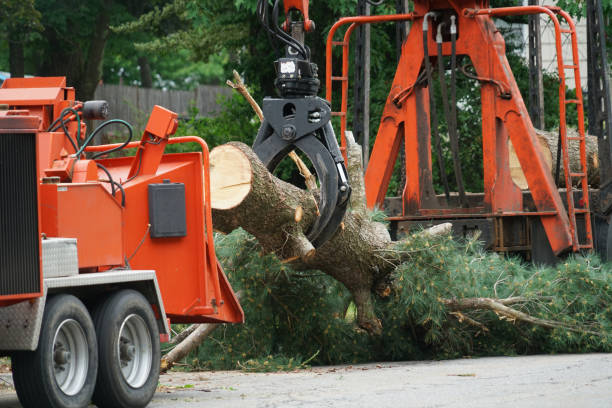In this comprehensive guide, we will delve into the often-overlooked yet crucial topic of tree health and safety.
We’ll help you decode the signs of a distressed tree and enlighten you on when it’s the appropriate time to rope in a tree removal service.
This isn’t merely about maintaining the beauty of your property, but also about safeguarding your home and the lives of your loved ones.
Don’t just leaf through; you might discover crucial insights that could potentially save your property and even lives.
Let’s branch out into this vital discussion.
(h2) Recognizing Signs of Tree Disease
Early detection is key to effective tree disease treatment.
By understanding the common signs and symptoms, you can take steps to protect your trees and prevent further damage.
Leaf Symptoms
- Chlorosis: Yellowing of leaves due to nutrient deficiencies or fungal infections.
- Necrosis: Browning or blackening of leaf tissue, often caused by fungal or bacterial diseases.
- Spotting: Small, discolored spots on leaves, frequently a sign of fungal diseases.
- Blistering: Raised, bubble-like lesions on leaves, often caused by fungal or bacterial infections.
- Wilting: Drooping or curling of leaves, which can be a symptom of water stress, root rot, or insect infestations.
Trunk and Branch Symptoms
- Cankers: Sunken, discolored areas on the bark, often caused by fungal or bacterial infections.
- Dieback: Progressive death of branches or twigs, often starting at the tips.
- Resin Flow: Excessive sap oozing from wounds or cracks in the bark.
- Fruiting Bodies: Fungal structures, such as mushrooms or conks, grow on the tree.
Root Symptoms
- Root Rot: Discolored, mushy, or decayed roots.
- Girdling Roots: Roots that encircle the trunk and restrict nutrient and water flow.
If you notice any of these signs, it’s important to consult with a certified arborist.
Evaluating Structural Stability of Trees
Ensuring the structural integrity of your trees is crucial for both property safety and aesthetic appeal.
Visual Inspection
- Leaning: A noticeable lean can indicate root damage or instability.
- Cavities and Decay: Holes or decaying wood in the trunk or branches can weaken the tree’s structure.
- Cracked or Split Bark: These can be signs of disease or physical damage.
- Branch Weaknesses: Look for dead, dying, or weak branches that may pose a hazard.
- Unusual Growth Patterns: Asymmetrical growth or excessive leaning can indicate stress or structural problems.
Root Health Assessment
- Exposed Roots: Visible roots may indicate soil erosion or root damage.
- Soil Conditions: Poor soil drainage or compaction can negatively impact root health.
Professional Evaluation
For a comprehensive assessment, consider consulting with a certified arborist.
- Measure Tree Stability: Assess factors like lean, stem decay, and root health.
- Identify Potential Hazards: Detect hidden issues like internal decay or fungal infections.
- Recommend Appropriate Actions: Provide advice on pruning, cabling, or removal, as needed.
Remember, a stable tree is a safe tree.
By regularly inspecting your trees and addressing any issues promptly, you can protect your property and loved ones.
Navigating the Tree Removal Process
Removing a tree can be a big decision, but with careful planning and the right approach, it can be a smooth process.
Assess the Situation
- Safety First: Evaluate the tree’s location and potential hazards.
- Permit Requirements: Check local regulations to determine if you need a permit for tree removal.
- Professional Consultation: Consider consulting with a certified arborist to get expert advice.
Choose a Reliable Tree Removal Service
- Research and Reviews: Look for reputable companies with experience and positive reviews.
- Licensing and Insurance: Ensure the company is licensed and insured to protect you from liability.
- Get Multiple Quotes: Compare prices and services to find the best deal.
Prepare for Removal
- Clear the Area: Remove any objects or structures that could be damaged during the removal process.
- Notify Neighbors: Inform your neighbors about the planned tree removal to avoid any misunderstandings.
- Consider Traffic and Utilities: Be aware of any potential impacts on traffic or underground utilities.
The Removal Process
- Tree Felling: The tree will be carefully felled using techniques like climbing, rigging, or mechanical equipment.
- Branch Removal: Larger branches will be removed and cut into smaller pieces.
- Stump Grinding: The stump can be ground down to below ground level or removed completely.
Cleanup and Disposal
- Debris Removal: The tree removal company will clean up the debris, including branches, leaves, and wood chips.
- Disposal: Wood chips can be used for landscaping or composted.
By following these steps and working with a reputable tree removal service, you can ensure a safe and efficient tree removal process.
Understanding the health of your trees and recognizing when it’s time to call a professional for tree removal is essential for maintaining the safety and beauty of your property.
Regularly checking your trees for signs of disease and structural instability can help prevent damage and loss.
If removal is necessary, following the right steps and working with a reliable tree removal service can ensure a smooth and efficient process.
Remember, tree care isn’t just about aesthetics; it’s also about safeguarding your home and the people you love.

